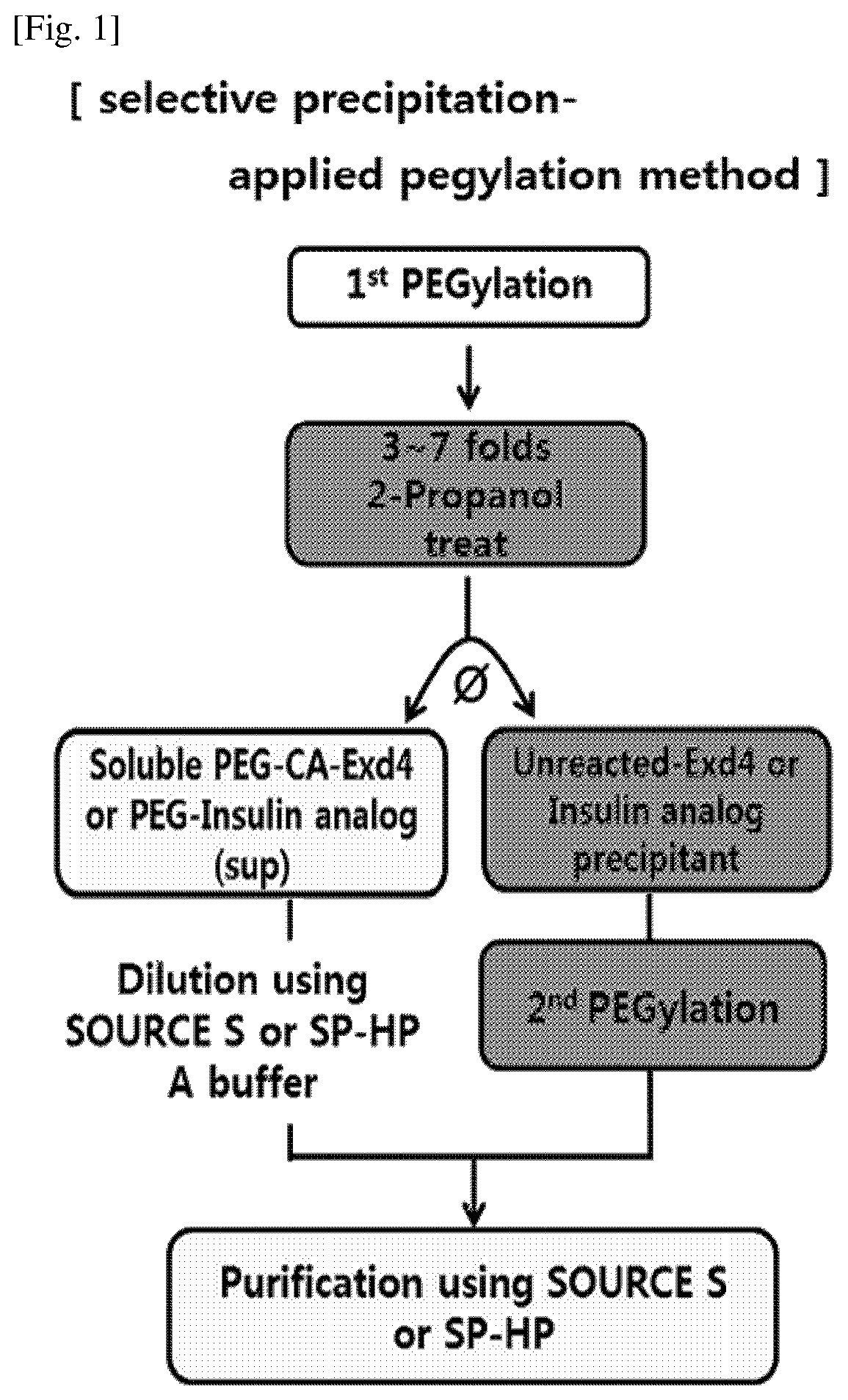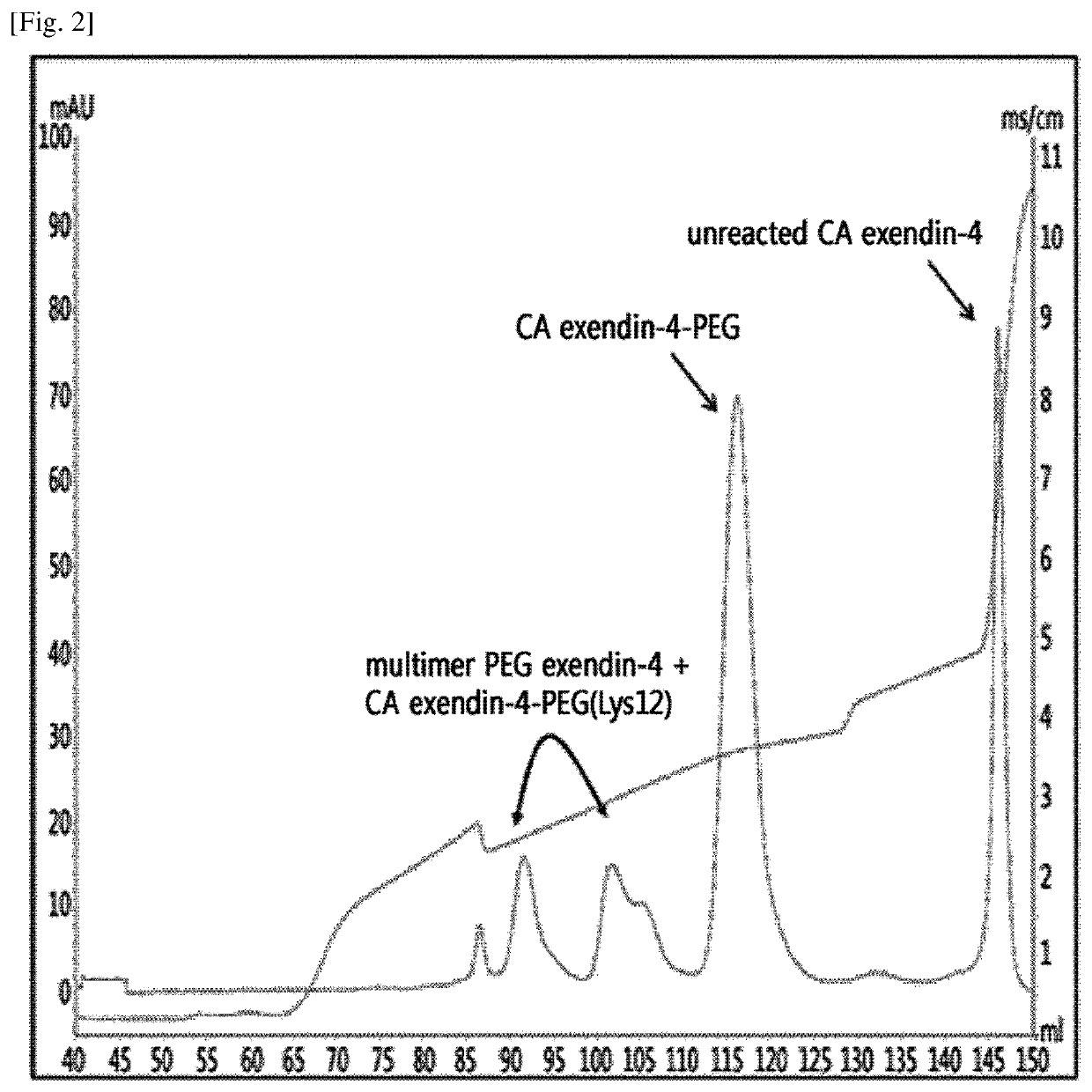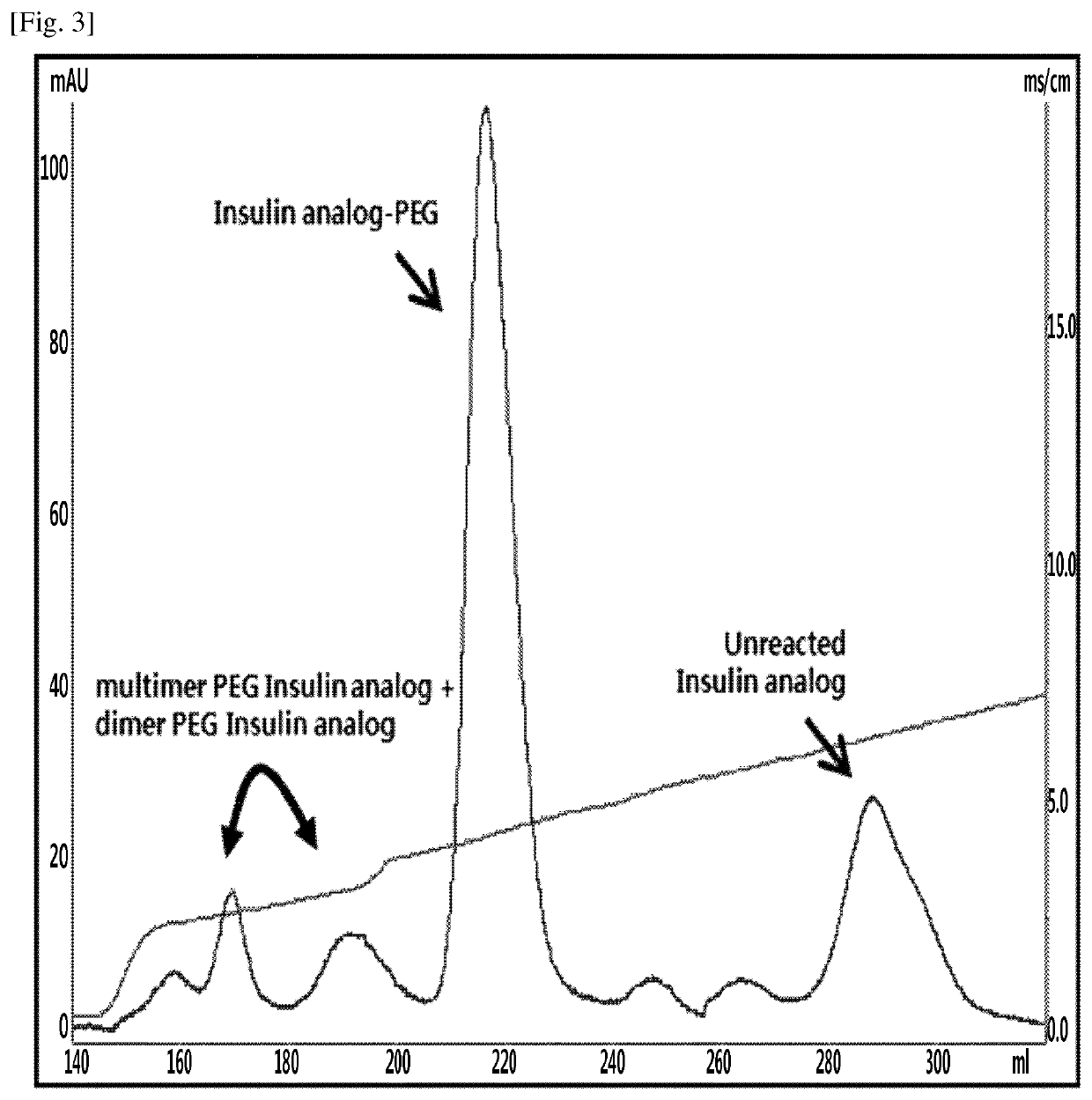Method of preparing physiologically active polypeptide conjugate
a polypeptide and conjugate technology, applied in the field of physiologically active polypeptide conjugate preparation, can solve the problems of easy denature, severe pain for patients, loss of activity, etc., and achieve the effects of high yield, increased blood half-life, and high level
- Summary
- Abstract
- Description
- Claims
- Application Information
AI Technical Summary
Benefits of technology
Problems solved by technology
Method used
Image
Examples
example 1
n of Imidazo-Acetyl Exendin-4 and Separation of Positional Isomers
[0125]3.4K ALD(2) PEG (a 3.4 kDa PEG having two aldehyde groups, NOF, Japan) was used to perform pegylation at Lys of imidazo-acetyl-exendin-4 (CA-exendin-4, Bachem, USA).
[0126]To pegylate the Lys position of imidazo-acetyl-exendin-4 using 3.4K ALD(2) PEG, the peptide and PEG were reacted at a molar ratio of about 1:3 to 1:30 with a peptide concentration of about 5 mg / mL to 18 mg / mL for 0.5 hours to 4.0 hours at 4° C. to 8° C. and 20° C. to 25° C. In this regard, the reaction was allowed to proceed in a 100 mM HEPES buffer solution at a pH of 6.5 to 7.5 with addition of a reducing agent, 20 to 30 mM SCB (NaCNBH3). Specific reaction conditions and a result of separation by the following method are shown in the following Tables 1 and 2. In detail, they were reacted at a peptide concentration of about 15 mg / mL for 3 hours at 4° C. to 8° C., and a result of separation by the following method is shown in FIG. 2.
[0127]Imida...
example 2
n of Insulin Analog and Separation of Positional Isomers
[0131]3.4K ALD(2) PEG was used to perform pegylation at the β chain N-terminus of an insulin analog (WO2014-133324, Hanmi Pharmaceutical Co., Ltd, Korea).
[0132]To pegylate the N-terminus position of insulin analog using 3.4K ALD(2) PEG, the peptide and PEG were reacted at a molar ratio of about 1:4 with a peptide concentration of about 5 mg / mL to 18 mg / mL for 0.5 hours to 4.0 hours at 4° C. to 8° C. and 20° C. to 25° C. In this regard, the reaction was allowed to proceed in a 50 mM sodium citrate buffer solution at a pH of 4.0 to 6.0 with addition of a reducing agent, 3-5 mM SCB (NaCNBH3). In detail, they were reacted at a peptide concentration of about 5 mg / mL for 2 hours at 4° C. to 8° C., and a result of separation by the following method is shown in FIG. 3.
[0133]Insulin analog-PEG was separated from each reaction solution using a SP-HP column with a linear concentration gradient of KCl in a citric acid buffer solution at pH...
example 3
n of Imidazo-Acetyl-Exendin-4 and Separation of Non-Pegylated Imidazo-Acetyl-Exendin-4 by Selective Precipitation Using Organic Solvent
[0135]3.4K ALD(2) PEG was used to perform pegylation at the Lys position of imidazo-acetyl-exendin-4 (CA-exendin-4, Bachem, USA).
[0136]The reaction conditions are the same as in Example 1. The pegylation solution was treated with isopropanol, 1-propanol, 1-butanol, acetone, acetonitrile in 2 volumes or more, specifically, with 3 to 7 volumes of that of the reaction solution. From the organic solvent-treated reaction solution, a pegylated imidazo-acetyl-exendin-4 aqueous solution and a non-pegylated, unreacted imidazo-acetyl-exendin-4 precipitate were separated (FIG. 4). Of these, the aqueous solution was purified in the same manner as in Example 1 (FIG. 6), and the content of each purified fraction is shown in the following Table 3.
[0137]
TABLE 3Fraction eluted from SOURCE S column (%)Recovery rate of precipitateTreatment amount of(PEG)n-imidazo-acety...
PUM
| Property | Measurement | Unit |
|---|---|---|
| molecular weight | aaaaa | aaaaa |
| molecular weight | aaaaa | aaaaa |
| concentration | aaaaa | aaaaa |
Abstract
Description
Claims
Application Information
 Login to View More
Login to View More - R&D
- Intellectual Property
- Life Sciences
- Materials
- Tech Scout
- Unparalleled Data Quality
- Higher Quality Content
- 60% Fewer Hallucinations
Browse by: Latest US Patents, China's latest patents, Technical Efficacy Thesaurus, Application Domain, Technology Topic, Popular Technical Reports.
© 2025 PatSnap. All rights reserved.Legal|Privacy policy|Modern Slavery Act Transparency Statement|Sitemap|About US| Contact US: help@patsnap.com



